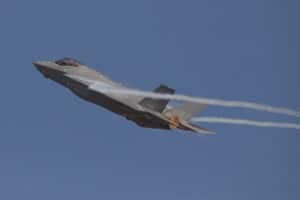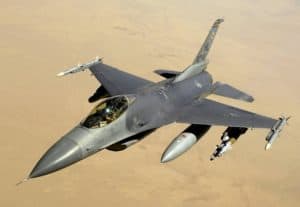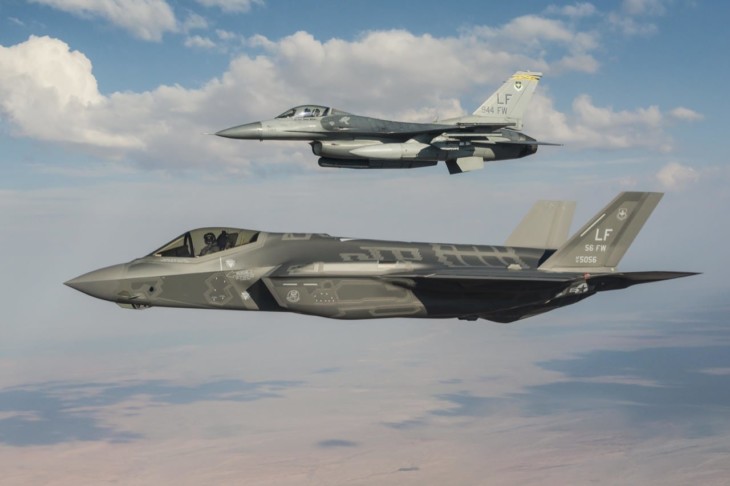The F35 and the F16 are both amazing fighter jets, but which one is better? In this article, we will compare the specs and features of these two aircraft to see which one comes out on top. Both jets are incredibly fast and maneuverable, but the F35 has some clear advantages over the F16.
Let’s take a closer look at each jet and see how they stack up against each other.
| Aircraft: | Lockheed Martin F-35 Lightning II | Lockheed Martin F-16 Fighting Falcon |
|---|---|---|
| Photo: |
 |
 |
| Country: | United States | United States |
| Manufactured: | from: 2011 to: Present | from: 1978 to: Present |
| ICAO: | F35 | - |
| Price: | $115.5 million | $18 million |
| Avionics: | JSF Cooperative Avionics | Lockheed Martin Tactical Aircraft Systems |
| Engine: | 1x Pratt & Whitney F135-PW-100 | 1 × Pratt & Whitney F100-PW-220 |
| Engine Type: | Turbofan | - |
| Power: | 43,000 pound-force | 29,160 pound-force |
| Max Cruise Speed: |
1043 knots 1,932 Km/h |
1147 knots 2,124 Km/h |
| Approach Speed (Vref): | 250 knots | - |
| Travel Range: |
1,500 Nautical Miles
2,778 Kilometers |
2,280 Nautical Miles
4,223 Kilometers |
| Fuel Economy: |
0.94 nautical mile / gallon 0.460 kilometres / litre |
- |
| Service Ceiling: | 65,000 feet | 50,000 feet |
| Rate of Climb: |
40000 feet / minute 203.20metre / second |
50000 feet / minute 254.00metre / second |
| Take Off Distance: |
168 metre 551.17 feet |
345 metre 1,131.88 feet |
| Landing Distance: |
213 metre 698.81 feet |
457 metre 1,499.33 feet |
| Max Take Off Weight: |
31,751 Kg 69,998 lbs |
19,187 Kg 42,300 lbs |
| Max Landing Weight: | - | - |
| Max Payload: |
8,160 Kg 17,990 lbs |
7,167 Kg 15,800 lbs |
| Fuel Tank Capacity: |
2,760 gallon 10,448 litre |
845 gallon 3,199 litre |
| Baggage Volume: | - | - |
| Seats - Economy: | 1 seats | 1 seats |
| Seats - Business Class: | - | - |
| Seats - First Class: | - | - |
| Cabin Height: | - | - |
| Cabin Width: | - | - |
| Cabin Length: | - | - |
| Exterior Length: |
15.7 metre 51.51 feet |
15.06 metre 49.41 feet |
| Tail Height: | 4.48 metre - 14.70 feet | - |
| Fuselage Diameter: | - | - |
| Wing Span / Rotor Diameter: |
10.7 metre 35.10 feet |
9.96 metre 32.68 feet |
| Wing Tips: | No Winglets | No Winglets |
| More Info: | Lockheed Martin F-35 Lightning II | Lockheed Martin F-16 Fighting Falcon |
|
Data presented is for entertainment purposes and should not be used operationally.
|
Other Lockheed Martin F-35 Lightning II comparisons:
- F-35 vs F-15
- F-35 vs F/A-18
- F-35 vs J-20
- F-35 vs MiG 25
- F-35 vs Saab Gripen
- F-35 vs Rafale
- F-35 vs A-10 Warthog
- F-35 vs Su 57
- F-35 vs MiG-29
- F-35 Lightning II vs A-10 Warthog
- F-22 Raptor vs F-35 Lightning II
- Eurofighter Typhoon vs Lockheed Martin F-35 Lightning II
Other Lockheed Martin F-16 Fighting Falcon comparisons:
The F-35 Lightning II

The F-35 is a 5th-generation multi-role fighter aircraft designed for ground attack, air superiority, and intelligence, surveillance, and reconnaissance missions. The F-35 has several unique features that set it apart from previous generations of fighter aircraft. That is, the F-35 is equipped with a powerful onboard computer that helps the pilot to identify and track targets.
In addition, the F-35 has advanced sensors that allow it to detect and avoid enemy missiles. Finally, the F-35 is equipped with stealth technology that makes it difficult for enemy radar to detect the aircraft.
Why was the F-35 built & designed?
The F-35 aircraft was conceived in the early 1990s as a multirole fighter that would replace older aircraft such as the F-16 and F/A-18. The F-35 is unique in that it was designed from the ground up to be a highly versatile platform, capable of performing a wide range of missions including air-to-air combat, close air support, and intelligence, surveillance, and reconnaissance.
One of the key features of the F-35 is its stealth technology, which makes it much harder for enemy radar to detect. The F-35 also features advanced sensors and avionics which allow it to gather and share information with other friendly assets in the battle space.
What purpose does the F-35 serve?
The F-35 aircraft is a fighter jet that serves several purposes in the military. Its primary purpose is to provide air support for ground troops. It can also be used for reconnaissance missions and to engage in dogfights with enemy aircraft. The F-35 is a versatile and effective aircraft that provides an important service for the military.
The F-35 has several features that make it well-suited for its various roles. It’s equipped with powerful engines that allow it to reach high speeds. It also has advanced sensors and targeting systems that allow it to locate and engage targets effectively.
The F-16 Fighting Falcon

The F-16 is a single-engine, supersonic fighter jet that was first introduced in the 1970s. It is still in production today and has been exported to over 25 countries. The F-16 has a wingspan of 9.45 meters (31 feet), a length of 15.06 meters (49.5 feet), and a height of 5.09 meters (16.7 feet). It has a maximum speed of Mach 2 (twice the speed of sound) and a range of 4,200 kilometers (2,600 miles).
The F-16 is armed with a variety of missiles and bombs, including air-to-air and air-to-ground missiles. It can also carry up to six hydraulic or electric drop bombs.
The F-16 is powered by a General Electric F110 or Pratt & Whitney F100 turbofan engine, which gives it a thrust-to-weight ratio of more than one (meaning it can accelerate even when carrying a full weapons load).
Why was the F-16 built & designed?
The F-16 aircraft was built and developed for a variety of reasons. First, the F-16 was designed to be a highly maneuverable fighter aircraft. It had to be able to outmaneuver enemy aircraft, both in the air and on the ground. Second, the F-16 was designed to be a very effective air-to-air combat aircraft.
It had to be able to engage and defeat enemy aircraft in combat. Third, the F-16 was designed to be an effective air-to-ground combat aircraft. It had to be able to engage and destroy enemy targets on the ground. Lastly, the F-16 was designed to be an affordable fighter aircraft. The F-16 had to be affordable to produce and operate.
What purpose does the F-16 serve?
The F-16 aircraft is a highly maneuverable fighter plane that was first introduced in the early 1970s. It is designed to be flown by a single pilot and can reach speeds of up to Mach 2. The F-16 has been used by the military in some conflict zones, including Kosovo, Afghanistan, and Iraq. Its primary function is to provide air support for ground troops. It can also be used for reconnaissance missions and to engage in dogfights with enemy aircraft.
The F-16 is equipped with various weapons, including air-to-air missiles, bombs, and machine guns.
Similarities between the F-35 & F-16
One major similarity between the two aircraft is that they both share the same engine, the General Electric F110. The F-35 has 25% more thrust than the F-16, however, due to its weight, it cannot sustain supersonic speeds for as long. The F-35 has slightly larger dimensions than the F-16.
Both aircraft have wingtip mounted missiles, but on the F-35 these are for self-defense only and do not provide any extra range or firepower.
The F-35 has much more internally integrated avionics and sensor fusion than the F-16, meaning that the pilot has a lot more information available to them at any one time.
Differences between the F-35 & F-16
The F-35 is a fifth-generation fighter jet, while the F-16 is a fourth-generation jet. This means that the F-35 is more technologically advanced than the F-16, with upgraded sensors, avionics, and weapons systems. The F-35 also has stealth capabilities that allow it to evade detection by radar.
The F-35 is larger and heavier than the F-16, making it more difficult to maneuver at high speeds. However, its extra weight also gives it more power and range. The F-35 can carry a heavier payload of weapons than the F-16, making it more versatile in combat.
The F-35 has a single engine, while the F-16 has two engines. This gives the F-35 better fuel efficiency, but it also means that if one engine fails, the jet cannot continue flying. The F-16’s two engines give it increased redundancy and safety in case of engine failure.
F-35: What’s Better
The F-35 is a better aircraft than the F-16 in many ways. For one, the F-35 is stealthier due to its shape and the materials used in its construction. This makes it much harder for enemy radar to detect and track the F-35, giving it a significant advantage in combat. Additionally, the F-35 has more powerful engines than the F-16, providing it with greater speed and agility.
The F-35 also has a more sophisticated sensor suite than the F-16, giving pilots greater situational awareness.
F-16: What’s Better
The F-16 is a better aircraft than the F-35. The F-16 has been in production for over 40 years, longer than any other fighter aircraft. The F-35 is a newer model and has not been in production as long. F-16 has been battle-tested and proven in combat. F-35 has not seen as much combat. The F-16 is less expensive to operate and maintain than the F-35. The F-35 has more expensive sensors and requires more maintenance.
The F-16 has a higher thrust-to-weight ratio than the F-35. The F-16 can take off and land on shorter runways than the F-35.
Conclusion: F35 vs F16
The F-35 is a better aircraft than the F-16 in many ways. However, the F-16 has been battle-tested and proven in combat. It is also less expensive to operate and maintain. The F-16 has a higher thrust-to-weight ratio and can take off and land on shorter runways. Therefore, the F-16 is the better aircraft.

